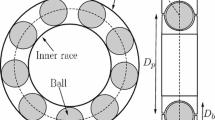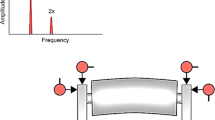Abstract
Bearing failure is one of the most important causes of shutdown in rotating machines. Most bearing diagnostic methods can only be used on machines with steady-state operational conditions. Changes in operating conditions cause changes in the statistical characteristics of the vibrating signals, which causes erroneous alarms related to bearing failure. The statistical index of vibration signals, independent of operating conditions of speed and load, is introduced in this paper to diagnosis bearing fault growth and reduce the rate of incorrect bearing failure alarms. The existing theoretical model is employed to simulate and extract the vibration database under variable operational conditions and finally, to extract the statistical index according to vibration surface plot parameters. Surface plots of acceleration RMS versus speed and load were used for extract statistical index and experimental laboratory data are also used to verify the proposed index.










Similar content being viewed by others
Abbreviations
- \(k_{{{\text{in}}/{\text{out }}j \cdot r}}\) :
-
Nonlinear contact stiffness
- \(c_{{{\text{in}}/{\text{out }}j \cdot r}}\) :
-
Linear contact damping
- \(m_{0} \cdot m_{b} \cdot m_{i}\) :
-
Mass of the outer raceway plus the support structure, rolling element, inner raceways plus the shaft
- \(\theta_{{{\text{out}} j \cdot r}}\) :
-
The angle of the vector \(\overrightarrow {{z_{j \cdot r} }}\) with respect to the center of the outer raceway
- \(m_{r} \cdot { }k_{r} \cdot { }c_{r}\) :
-
Spring mass damping system correspond to excitation of the bending modes of the casing, which results in vibrations across the entire casing
- \(F_{{{\text{in}}}} \cdot { }F_{{{\text{out}}}}\) :
-
Total contact forces acting on the inner race and outer race
- \(F_{{\text{d in}}} \cdot { }F_{{\text{d out}}}\) :
-
Total contact damping forces acting on the inner race and outer race
- \(k_{s} \cdot { }c_{s}\) :
-
Stiffness and damping of the support
- \(R\left( \varphi \right)\) :
-
The distance between the outer raceway and the center of the outer raceway at angle \(\varphi = \theta_{{{\text{out}} j \cdot r}} + \psi_{j \cdot r}\)
- \(\psi_{j \cdot r}\) :
-
The angle between the point of the maximum deformation and the vector \(\overrightarrow {{z_{j \cdot r} }}\)
- \(\beta_{j \cdot r}\) :
-
The angle of the deformation location on the rolling element
- \(\phi_{j \cdot r}\) :
-
The angular position of the jth rolling element of the rth row
- \(\rho_{j \cdot r}\) :
-
Generalized coordinates defined for the rolling elements
- \(\left\{ {f_{r} } \right\}\) :
-
Vector with generalized contact forces
- \(\overrightarrow {{z_{j \cdot r} }}\) :
-
Distance of the rolling element from the center of the outer raceway
- \(W\) :
-
Static load
- \({m}_{b}\) :
-
Mass of a rolling element
- \({\omega }_{c}\) :
-
Nominal rotational speed
- \(\delta_{{{\text{out}} j \cdot r}}\) :
-
Deformation toward the center of the outer raceway
- \({\delta }_{b j\cdot r}\) :
-
Deformation perpendicular to the jth rolling element
- \({r}_{b}\) :
-
The rolling element radius
References
Lu B, Nowak M, Grubic S, Habetler TG (2009) An adaptive noise-cancellation method for detecting generalized roughness bearing faults under dynamic load conditions. In: Energy Conversion Congress and Exposition, ECCE 2009, IEEE, pp 1091–1097
Huang N et al. (1998) The empirical mode decomposition and the Hilbert spectrum for nonlinear and non-stationary time series analysis. In: Proceedings of the Royal Society of London A: mathematical, physical and engineering sciences, vol 454, no 1971, The Royal Society, pp 903–995
Wang Z, Yang J, Guo Y (2022) Unknown fault feature extraction of rolling bearings under variable speed conditions based on statistical complexity measures. Mech Syst Signal Process 172:108964
Safizadeh M, Latifi S (2014) Using multi-sensor data fusion for vibration fault diagnosis of rolling element bearings by accelerometer and load cell. Inf Fusion 18:1–8
Zhao M, Lin J, Xu X, Li X (2014) Multi-fault detection of rolling element bearings under harsh working condition using IMF-based adaptive envelope order analysis. Sensors 14(11):20320–20346
Dong S, He K, Tang B (2020) The fault diagnosis method of rolling bearing under variable working conditions based on deep transfer learning. J Braz Soc Mech Sci Eng 42:1–13
Wang H, Jiang W, Deng X, Geng J (2021) A new method for fault detection of aero-engine based on isolation forest. Measurement 185:110064
Chen H, Ma H, Chu X, Xue D (2020) Anomaly detection and critical attributes identification for products with multiple operating conditions based on isolation forest. Adv Eng Inform 46:101139
Sim J, Min J, Kim S, Lee SW, Choi J-H (2023) Construction of bearing health indicator under time-varying operating conditions based on Isolation Forest. Eng Appl Artif Intell 126:107058
Randall R, Smith W (2016) New cepstral methods for the diagnosis of gear and bearing faults under variable speed conditions. In: ICSV23 conference, Athens
Zimroz R, Bartelmus W, Barszcz T, Urbanek J (2014) Diagnostics of bearings in presence of strong operating conditions non-stationarity—a procedure of load-dependent features processing with application to wind turbine bearings. Mech Syst Signal Process 46(1):16–27
Sawalhi N, Randall R (2008) Simulating gear and bearing interactions in the presence of faults: Part I. the combined gear bearing dynamic model and the simulation of localised bearing faults. Mech Syst Signal Process 22(8):1924–1951
Sawalhi N, Randall R (2008) Simulating gear and bearing interactions in the presence of faults: Part II: simulation of the vibrations produced by extended bearing faults. Mech Syst Signal Process 22(8):1952–1966
Petersen D, Howard C, Sawalhi N, Ahmadi AM, Singh S (2015) Analysis of bearing stiffness variations, contact forces and vibrations in radially loaded double row rolling element bearings with raceway defects. Mech Syst Signal Process 50:139–160
Ahmadi AM, Petersen D, Howard C (2015) A nonlinear dynamic vibration model of defective bearings—the importance of modelling the finite size of rolling elements. Mech Syst Signal Process 52:309–326
Moazen-Ahmadi A, Howard CQ (2016) A defect size estimation method based on operational speed and path of rolling elements in defective bearings. J Sound Vib 385:138–148
Larizza F, Howard CQ, Grainger S, Wang W (2021) A nonlinear dynamic vibration model of a defective bearing: the importance of modelling the angle of the leading and trailing edges of a defect. Struct Health Monit 20(5):2604–2625
Ag FK (2003) Rolling bearing damage recognition of damage and bearing inspection. Publ No WL 82(102):2
Zhang B, Sconyers C, Byington C, Patrick R, Orchard M, Vachtsevanos G (2008) Anomaly detection: a robust approach to detection of unanticipated faults. In 2008 International Conference on Prognostics and Health Management, IEEE, pp 1–8
Wang F, Jing M, Yi J, Dong G, Liu H, Ji B (2015) Dynamic modelling for vibration analysis of a cylindrical roller bearing due to localized defects on raceways. Proc Inst Mech Eng Part K J Multi-body Dyn 229(1):39–64
Larizza F, Moazen-Ahmadi A, Howard CQ, Grainger S (2017) The importance of bearing stiffness and load when estimating the size of a defect in a rolling element bearing. Struct Health Monit 18:1475921718808805
Cui L, Jin Z, Huang J, Wang H (2019) Fault severity classification and size estimation for ball bearings based on vibration mechanism. IEEE Access 7:56107–56116
Syniuta W, Corrow C (1970) A scanning electron microscope fractographic study of rolling-contact fatigue. Wear 15(3):187–199
El-Thalji I, Jantunen E (2015) Dynamic modelling of wear evolution in rolling bearings. Tribol Int 84:90–99
Petersen D, Howard C, Prime Z (2015) Varying stiffness and load distributions in defective ball bearings: analytical formulation and application to defect size estimation. J Sound Vib 337:284–300
Ahmadi AM, Howard CQ, Petersen D (2016) The path of rolling elements in defective bearings: observations, analysis and methods to estimate spall size. J Sound Vib 366:277–292
Larizza F, Howard CQ, Grainger S, Wang W (2017) Modelling of defective bearings-the importance of the leading and trailing edge angle of a defect. In: 17th Australian International Aerospace Congress: AIAC 2017, Engineers Australia, Royal Aeronautical Society, p 703
Nistane V, Harsha S (2018) Performance evaluation of bearing degradation based on stationary wavelet decomposition and extra trees regression. World J Eng 15(5):646–658
Van Hecke B, Yoon J, He D (2016) Low speed bearing fault diagnosis using acoustic emission sensors. Appl Acoust 105:35–44
Acknowledgements
The authors express thanks to Shahid Tondgooyan Petrochemical Company (STPC), Iran National Science Foundation (INSF) under grant 97009084 for financial support and Dr. Somaye Mohammadi for revising the article text.
Funding
The research leading to these results received funding from Shahid Tondgooyan Petrochemical Company and Iran National Science Foundation (INSF) under Grant Agreement No 97009084.
Author information
Authors and Affiliations
Corresponding author
Additional information
Technical Editor: Jarir Mahfoud.
Publisher's Note
Springer Nature remains neutral with regard to jurisdictional claims in published maps and institutional affiliations.
Rights and permissions
Springer Nature or its licensor (e.g. a society or other partner) holds exclusive rights to this article under a publishing agreement with the author(s) or other rightsholder(s); author self-archiving of the accepted manuscript version of this article is solely governed by the terms of such publishing agreement and applicable law.
About this article
Cite this article
Samavatian, M., Behzad, M. & Mehdigholi, H. Nonlinear modeling for bearing fault diagnosis in non-stationary operating conditions. J Braz. Soc. Mech. Sci. Eng. 46, 323 (2024). https://doi.org/10.1007/s40430-024-04898-8
Received:
Accepted:
Published:
DOI: https://doi.org/10.1007/s40430-024-04898-8




